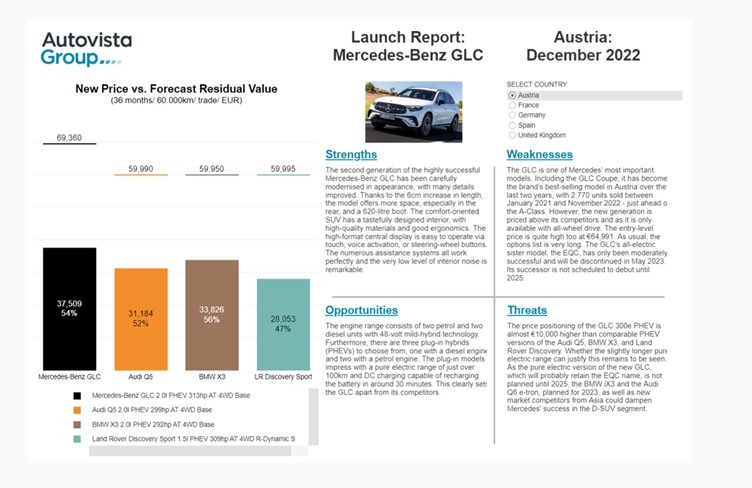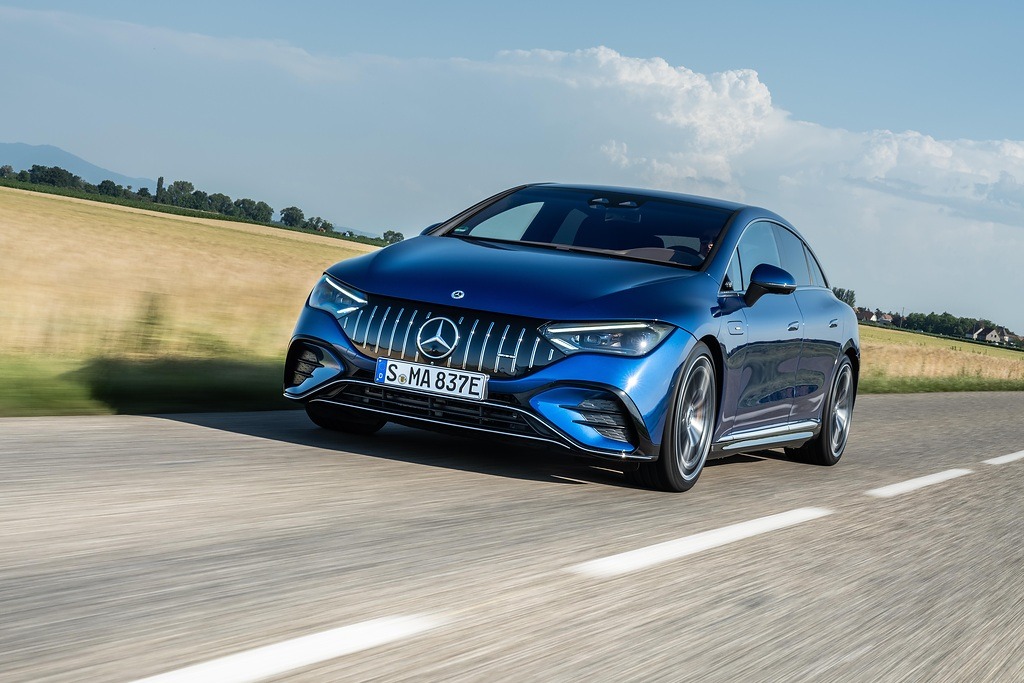Launch Report: Mercedes-Benz GLC offers evolutionary efficiency at a price
16 December 2022

The exterior of the second-generation Mercedes-Benz GLC (X254) has evolved conservatively but looks modern compared to facelifted rivals that are late in their lifecycle. The 6cm increase in length provides a spacious cabin and the 620-litre boot of the internal-combustion engine (ICE) versions is, on average, 50 litres larger than in key competitors.
The car is comfortable to drive, with very good soundproofing and powerful braking – even with the heavier plug-in hybrid (PHEV) powertrain. Rear-wheel steering improves handling as well as helping with parking and city driving.
The interior looks up-to-date compared to the rather outdated dashboard layouts of rivals. It offers good material quality and haptics, with a large 12.3-inch vertical screen that is easy to operate via touch, voice activation, or steering-wheel buttons. However, this will not suit every customer and can take time to get used to.
The high level of standard equipment includes advanced driver-assistance systems (ADAS), a front camera for narrow roads or all-terrain driving, and the latest ‘Hey Mercedes’ voice activation for the MBUX operating system.
Efficiency gains
Mercedes-Benz is offering a full range of powertrains for the GLC, including 48-volt mild-hybrid petrol or diesel engines and plug-in hybrid (PHEV) versions. Across all powertrains, fuel consumption figures are lower overall than those of rivals.
However, the new GLC is priced above key competitors such as the Audi Q5, BMW X3, Land Rover Discovery Sport, and Volvo XC60. Demand for high-priced cars may suffer amid the cost-of-living crisis and the GLC is especially exposed as there are no cheaper, six-cylinder diesel or two-wheel-drive variants available.
The PHEV versions offer class-leading pure electric range over 100km, which is suitable for everyday use and shorter trips without the need to recharge during the week. Furthermore, a DC connection can fully recharge the battery in around 30 minutes, or replenish it from 10% to 80% in 20 minutes. These positive attributes set the GLC apart from its competitors but whether Mercedes-Benz can justify the higher price remains to be seen.
Mounting competition
The GLC is the newest entrant in the D-SUV segment and can capitalise on the age of its premium competitors. Conversely, these models are up for renewal within the next 12 months. Cheaper powertrain combinations would help to stave them off, especially as the exterior design might appear to be more of a facelift than a new model generation. Furthermore, if buyers can overlook the ‘prestige’ factor, there are many other good competitors with a lower list price.
The interior space, wheelbase, and boot size of the GLC are not sufficiently differentiated from the similarly-sized but much cheaper GLB – only the engine offering and interior quality stand out. Moreover, the GLC does not have a third row of seats, meaning buyers needing more than five seats will opt instead for the GLB C-SUV or the much larger and more expensive GLS.
Several highly capable SUV battery-electric vehicles (BEVs) have been, or soon will be, launched. Meanwhile, the GLC’s all-electric sister model, the EQC, will be discontinued in 2023. The car has only been moderately successful – partly because D-SUV BEVs are uncompetitive in terms of total cost of ownership (TCO) as they are not eligible for incentives. Its successor will probably retain the EQC name but is not scheduled to debut until 2025.
The BMW iX3 and the Audi Q6 e-Tron, planned for 2023, as well as new BEV competitors from Asia, could dampen Mercedes’ success in the D-SUV segment.
View the Autovista Group dashboard, which benchmarks the Mercedes-Benz GLC in Austria, France, Germany, Spain, and the UK for more details. The interactive launch report presents new prices, forecast residual values, and SWOT (strengths, weaknesses, opportunities, and threats) analysis.




